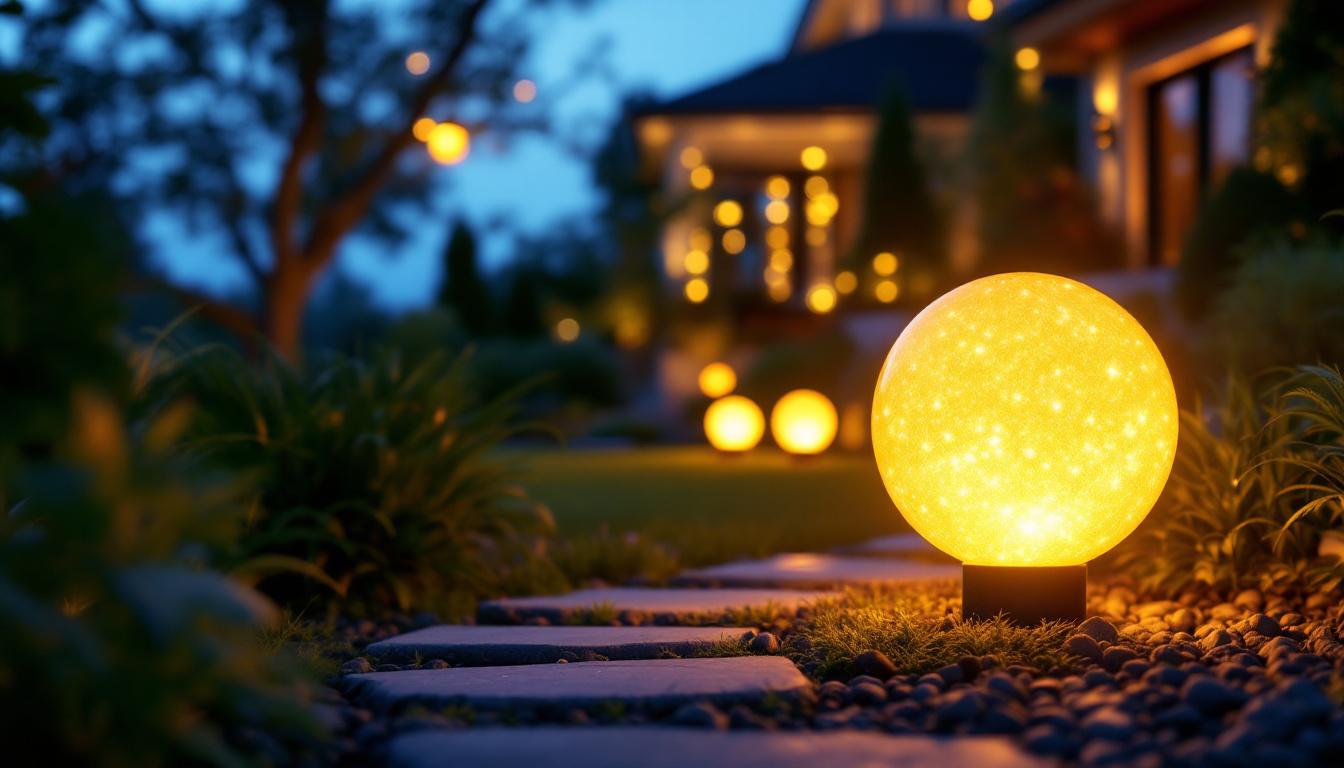
As the lighting industry continues to evolve, the integration of sustainable and energy-efficient solutions has become paramount. Solar uplights represent a significant innovation within this landscape, offering lighting contractors a versatile and eco-friendly option for both residential and commercial projects. These devices harness solar energy to illuminate outdoor spaces, reducing reliance on traditional power sources and minimizing environmental impact.
Understanding the role of solar uplights in modern lighting solutions is essential for contractors aiming to meet client demands for sustainability without compromising on quality or functionality. This article explores the technology behind solar uplights, their advantages, practical applications, and considerations for effective implementation in various projects.
Solar uplights are designed with advanced photovoltaic cells that capture sunlight during the day and convert it into usable energy for nighttime illumination. This technology not only provides a reliable source of light but also ensures that the fixtures are self-sufficient, requiring minimal maintenance and installation effort. Many models come equipped with motion sensors and adjustable brightness settings, allowing for enhanced security and energy savings. As a result, solar uplights can be strategically placed to highlight architectural features, illuminate pathways, or enhance garden aesthetics, all while aligning with eco-conscious design principles.
Moreover, the versatility of solar uplights extends beyond mere aesthetics; they can be utilized in various settings, from residential backyards to commercial landscapes and public parks. Their ability to operate independently of electrical wiring makes them an ideal choice for remote or hard-to-reach areas where traditional lighting solutions may pose logistical challenges. Additionally, advancements in battery technology have improved the performance of solar uplights, allowing them to function effectively even on cloudy days or during shorter daylight hours. This adaptability ensures that clients can enjoy consistent and reliable lighting, enhancing the safety and ambiance of outdoor spaces throughout the year.
Solar uplights operate by converting sunlight into electrical energy through photovoltaic (PV) panels integrated into the fixture. During daylight hours, the PV cells capture solar radiation and store the energy in rechargeable batteries. When darkness falls, the stored energy powers LED bulbs, casting light upwards to highlight architectural features, landscaping, or signage.
The efficiency of solar uplights depends largely on the quality of the PV cells, battery capacity, and LED technology. Advances in these components have significantly improved performance, enabling longer illumination times and brighter outputs even in areas with limited sunlight exposure. For instance, some modern solar uplights utilize monocrystalline solar cells, which are known for their high efficiency and performance in low-light conditions, thereby extending the usability of the lights even during cloudy days or in shaded areas.
Modern solar uplights come in a variety of designs, ranging from sleek, minimalist forms to more decorative styles that blend seamlessly with outdoor aesthetics. For lighting contractors, selecting the right design involves balancing functional requirements such as light intensity and beam angle with the visual impact on the environment. The choice of color temperature is also crucial; warmer tones can create a cozy atmosphere, while cooler tones may be more suitable for modern or contemporary settings.
Durability is another critical factor. High-quality solar uplights are typically constructed with weather-resistant materials like anodized aluminum or stainless steel, ensuring they withstand harsh outdoor conditions. Additionally, many models feature IP65 or higher ratings for water and dust resistance, which is essential for long-term reliability. Beyond materials, the design should also consider ease of installation and maintenance. Some solar uplights come with adjustable heads or rotatable bases, allowing for versatile positioning and optimal light direction, which can be particularly beneficial in dynamic landscaping projects where features may need to be highlighted differently throughout the seasons.
One of the most compelling benefits of solar uplights is their ability to operate independently of the electrical grid. By utilizing renewable solar energy, these fixtures eliminate electricity costs associated with traditional lighting systems. Over time, this translates into substantial savings for property owners and reduces the overall carbon footprint of the project.
For lighting contractors, promoting energy efficiency can be a strong selling point, particularly for clients who prioritize sustainability or face increasing energy expenses. Moreover, the absence of wiring reduces installation complexity and labor costs, accelerating project timelines.
Solar uplights are inherently flexible due to their wireless nature. They can be installed in locations where running electrical wiring is impractical or cost-prohibitive, such as remote gardens, pathways, or historic sites with preservation restrictions. This flexibility opens up creative possibilities for lighting design that were previously challenging to execute.
Installation typically involves securing the fixture in place and ensuring the solar panel receives adequate sunlight. This simplicity allows contractors to complete installations quickly and with minimal disruption, an advantage in both new construction and retrofit scenarios.
With growing awareness of environmental issues, solar uplights align perfectly with green building standards and certifications such as LEED and BREEAM. By incorporating solar lighting, contractors contribute to reducing greenhouse gas emissions and dependence on fossil fuels.
Furthermore, many solar uplights utilize LEDs, which are known for their low energy consumption and long lifespan. This combination of solar power and LED technology represents a forward-thinking approach that supports sustainable development goals.
In residential settings, solar uplights are commonly used to accentuate garden features, trees, and architectural elements. Their upward illumination creates dramatic effects that enhance curb appeal and add value to the property. Additionally, strategically placed solar uplights improve nighttime visibility and security without the need for extensive wiring.
Homeowners increasingly seek lighting solutions that are both attractive and environmentally responsible, making solar uplights an ideal choice for landscape designers and contractors working in the residential market.
Solar uplights are equally valuable in commercial environments such as parks, plazas, and building facades. They provide energy-efficient illumination that highlights branding elements or public art installations while reducing operational costs for municipalities and businesses.
In public spaces, the ease of installation and maintenance of solar uplights is a significant advantage. Without the need for trenching or electrical infrastructure upgrades, these fixtures can be deployed rapidly, enhancing safety and aesthetics with minimal disruption.
Historic preservation projects often face restrictions on electrical modifications to protect the integrity of structures. Solar uplights offer a non-invasive solution to illuminate such sites, preserving their character while improving visibility and visitor experience.
Similarly, remote locations without access to reliable power grids benefit from solar uplighting, enabling contractors to deliver effective lighting solutions in challenging environments. This capability expands the scope of projects that can incorporate high-quality outdoor lighting.
Successful implementation of solar uplights begins with a thorough site assessment. Lighting contractors must evaluate solar exposure throughout the day to ensure panels receive sufficient sunlight for optimal charging. Factors such as shading from trees, buildings, or other structures can significantly impact performance.
Using tools like solar pathfinders or digital mapping software can aid in identifying the best locations for fixtures and panels, maximizing energy harvest and illumination quality.
Selecting solar uplights with appropriate lumen output, color temperature, and beam angle is crucial to achieving the desired lighting effect. Contractors should consider the specific needs of the project—whether highlighting architectural details, providing ambient light, or enhancing safety—and choose fixtures accordingly.
Battery capacity and charging time are also important specifications. High-capacity lithium-ion batteries generally offer longer life and better performance compared to older nickel-metal hydride options, ensuring reliable illumination through the night.
While solar uplights require less maintenance than wired systems, periodic care is necessary to maintain optimal performance. Cleaning solar panels to remove dust and debris, checking battery health, and inspecting fixtures for damage help extend the lifespan of the installation.
Lighting contractors can offer maintenance plans or guidance to clients, reinforcing the value of solar uplights as a long-term investment in sustainable lighting.
One inherent challenge with solar uplights is their dependence on weather conditions. Extended periods of overcast skies or heavy rainfall can reduce charging efficiency, potentially limiting illumination duration. Contractors must set realistic expectations with clients and design systems with sufficient battery capacity to mitigate these effects.
In regions with limited sunlight during certain seasons, hybrid solutions that combine solar with low-voltage wiring may be advisable to ensure consistent lighting.
Although solar uplights eliminate ongoing electricity costs, their upfront price can be higher than conventional fixtures. Lighting contractors should present a comprehensive cost-benefit analysis to clients, highlighting long-term savings, reduced installation expenses, and environmental benefits.
Incentives such as tax credits or rebates for renewable energy installations can further improve the financial viability of solar uplighting projects.
Modern lighting design increasingly incorporates smart controls for enhanced functionality and energy management. Integrating solar uplights with these systems presents technical challenges due to their off-grid nature and limited power availability.
However, advancements in wireless communication and low-power electronics are enabling more sophisticated solar lighting solutions that can be remotely monitored and controlled, expanding their appeal to tech-savvy clients.
Solar uplights are transforming the way lighting contractors approach outdoor illumination, combining sustainability, cost-effectiveness, and design flexibility. As technology advances and environmental regulations become more stringent, the demand for solar-powered lighting solutions is expected to grow.
By understanding the capabilities, benefits, and challenges of solar uplights, lighting contractors can position themselves as leaders in delivering innovative, eco-friendly lighting projects that meet the evolving needs of clients and communities alike.
Ready to lead the charge in sustainable outdoor lighting? LumenWholesale is here to support your journey with premium solar uplights that merge eco-friendliness with cutting-edge design. Our spec-grade lighting products set the standard for quality and value, ensuring you can deliver exceptional lighting solutions to your clients. Say goodbye to inflated markups and hello to hassle-free bulk purchasing with free shipping. Elevate your lighting projects with the best value in wholesale lighting. Explore our collection now and bring your designs to life with LumenWholesale.

Discover how solar powered yard globes are revolutionizing outdoor lighting for contractors.

Discover how the Cellring Fan is revolutionizing the lighting industry by providing contractors with a competitive edge.

Explore the rising significance of LED retrofit recessed lighting in the evolving lighting industry.

Discover the latest trends in ceiling shop lights that every lighting contractor should know.